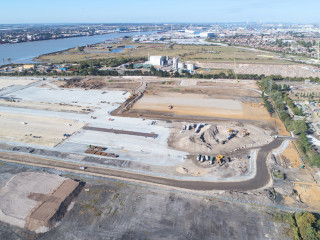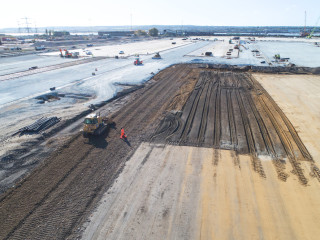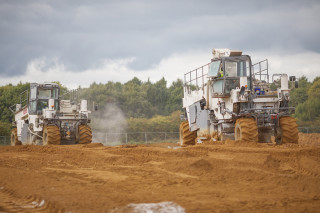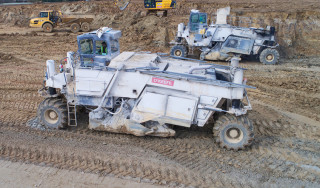The O’Keefe Group is using cement stabilisation techniques to prepare the site of a decommissioned power station for its redevelopment as a container storage facility for the Port of Tilbury.
Known as Tilbury2, the new £200m port terminal, which is adjacent to the existing 930-acre site in Thurrock, will become the UK’s largest unaccompanied freight ferry port and the country’s biggest construction processing hub.
O’Keefe is working on the part of the site located on the north bank of the River Thames at Tilbury. The area was previously part of a coal-fired power station that was taken out of commission and finally demolished in 2017.
Now, principal contractor Graham is transforming this part of the development into a storage facility for containers at Tilbury2’s roll-on/roll-off container terminal.
The extensive brownfield site, covering approximately 250,000m2, must be levelled and compacted to a 30% CBR value before a layer of quarried type-1 aggregate can be laid as a base for the final reinforced concrete paving slab.
The task is complicated by the presence of numerous underground structures, namely concrete foundations that supported the now-demolished buildings.
“We are excavating all the obstructions and crushing them down for reuse as aggregate,” says O’Keefe’s contracts manager Brian Doogue. “That material is then used to back-fill drainage and service trenches.”
Ground conditions on the site are very variable and O’Keefe is using a fleet of specialist machines to treat the soil and produce a consistently stable base.
The main technique being employed is cement stabilisation which involves mixing cement powder with the soil in-situ. Once incorporated and evenly mixed into the soil, the cement cures, effectively stiffening the soil and increasing its bearing strength.
“Soil improvement and stabilisation is especially useful at this time of year when the weather’s bad and aggregate stockpiles are getting low,” says Doogue. “A major advantage of the process is that by improving the existing soil, you don’t have to take so much of it off-site.
“We use it frequently for all sorts of applications, such as piling mats and to create sub-base for car parks, roads and cut-and-fill earthworks,” he adds.
O’Keefe operates three German-made Wirtgen soil stabilisers – highly-specialised machines that work rather like enormous rotavators to mill the soil while mixing the cement into it. Once the Wirtgen machines have done their work, the ground is levelled and compacted using a Cat D6 dozer.
All three of O’Keefe’s Wirtgen mixers are of the integrated type – that is, they spread the cement or lime binding agents and simultaneously mix them into the soil as they travel over the site.
A simpler method is to spread the binding material over the site first, and then use a tractor-towed stabiliser to mix it into the soil.
Integrated mixers are very expensive pieces of kit, but they give better results, says Doogue:
“We only use integrated mixers because they’re more efficient and better for the environment. An integrated mixer mixes the cement powder into the ground as it goes; if you’re spreading cement powder over a site before you mix it in, the wind can often blow it around.”

This is not only messy – and potentially hazardous – but also wasteful and can deliver inconsistent results, explains Doogue.
“The main advantage of soil stabilisation on this project is that it has allowed Graham to use site-won material and import less aggregate,” he says.
Alongside the Wirtgen soil stabilisers is a fleet of 30-tonne tracked excavators, fitted with breakers and pulverisers, which are used to dig out and break up the buried concrete. This is then fed into a Pegson crusher which processes it into another source of reusable aggregate.
The company started work on the site in April 2019 and is on schedule to hand it over to Graham this month.
How it works
Soil stabilisation uses a combination of mechanical and chemical processes to transform a poor, weak soil into a granular material that can be compacted to a known strength and used for structural purposes.
The fact that this is done in-situ has obvious cost and efficiency benefits. In some cases it can even be used to process contaminated soil for reuse, cancelling the need to remove it from site for disposal at significant cost elsewhere.
However, cautions O’Keefe’s Brian Doogue, “the whole point of this method is that you’re technically improving the ground. It’s not a cure for contamination. That’s a completely separate activity”.
In heavy clay soils, lime is mixed into the ground first. As it hydrates, it removes water from the soil allowing it to be reduced to a friable material. Cement is then mixed into the soil to complete its transformation into a stable, granular material.
The process, dependent on both chemical and mechanical processes, needs to be carefully managed, says Doogue:
“We go to site and collect soil samples which then go to our in-house laboratory in Borough Green where we produce trial mixes. The samples are then sent to a UKAS-accredited lab where they are tested for organic matter and sulphates so we can ensure that it is suitable for stabilisation.”
This technique is now widely used to improve soils in all sorts of applications where it is deemed advantageous from an environmental, cost or practical point of view.
Although primarily employed as a means of improving soils in-situ in order to improve stability and bearing strength, it is also a useful way of improving excavated material for reuse.
This article was first published in the March 2020 issue of The Construction Index magazine.
UK readers can have their own copy of the magazine, in real paper, posted through their letterbox each month by taking out an annual subscription for just £50 a year. Click for details.
Got a story? Email news@theconstructionindex.co.uk






